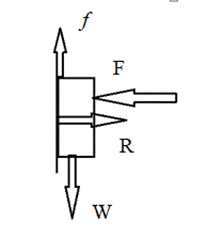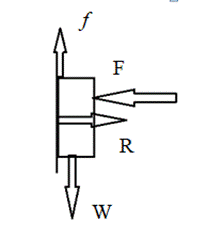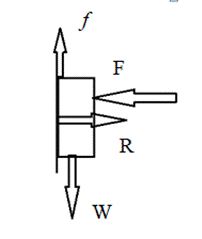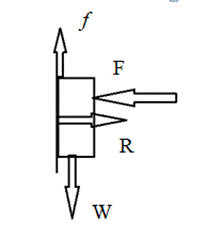
Concept explainers
(a)
The effect of weight of the book when reduce the applying force to the book in the same spot on the wall.
Answer to Problem 5QAP
The weight of the book is not changed.
Explanation of Solution
Introduction:
The book is pressed against on the wall. When we reduce the applying force to the book, the book remains in the same spot on the wall.

So the magnitude remains constant. Therefore weight stays the same.
Conclusion:
The weight stays the same.
(b)
The effect of the normal force of the wall on the book when reduce the applying force to the book in the same spot on the wall.
Answer to Problem 5QAP
The normal force of the wall on the book decreases.
Explanation of Solution
Introduction:
The book is pressed against on the wall. When we reduce the applying force to the book, the book remains in the same spot on the wall.

When applied force is reduced the normal force decreases.
Conclusion:
The normal force of the wall on the book decreases.
(c)
The effect of the frictional force of the wall on the book when reduce the applying force to the book in the same spot on the wall.
Answer to Problem 5QAP
The frictional force of the wall on the book is not changed.
Explanation of Solution
Introduction:
The book is pressed against on the wall. When we reduce the applying force to the book, the book remains in the same spot on the wall.

So the weight of the book is constant. Therefore the frictional force of the wall on the book stays same.
Conclusion:
The frictional force of the wall on the book stays same.
(d)
The effect of the maximum static frictional force of the wall on the book when reduce the applying force to the book in the same spot on the wall.
Answer to Problem 5QAP
The maximum static frictional force of the wall on the book deceases.
Explanation of Solution
Introduction:
The book is pressed against on the wall. When we reduce the applying force to the book, the book remains in the same spot on the wall.

When F reduces R decreases. Since
Conclusion:
The maximum static frictional force of the wall on the book deceases.
Want to see more full solutions like this?
Chapter 5 Solutions
COLLEGE PHYSICS
- A crate remains stationary after it has been placed on a ramp inclined at an angle with the horizontal. Which of the following statements must be true about the magnitude of the frictional force that acts on the crate? (a) It is larger than the weight of the crate. (b) It is at least equal to the weight of the crate. (c) It is equal to sn. (d) It is greater than the component of the gravitational force acting down the ramp. (e) It is equal to the component of the gravitational force acting down the ramp.arrow_forwardA block of ice (m = 15.0 kg) with an attached rope is at rest on a frictionless surface. You pull the block with a horizontal force of 95.0 N for 1.54 s. a. Determine the magnitude of each force acting on the block of ice while you are pulling. b. With what speed is the ice moving after you are finished pulling? Repeat Problem 71, but this time you pull on the block at an angle of 20.0.arrow_forwardA 3.00-kg object is moving in a plane, with its x and y coordinates given by x = 5t2 1 and y = 3t3 + 2, where x and y are in meters and t is in seconds. Find the magnitude of the net force acting on this object at t = 2.00 s.arrow_forward
- This force can either push the block upward at a constant velocity or allow it to slide downward at a constant velocity. The magnitude of the force is different in the two cases, while the directional angle θ is the same. Kinetic friction exists between the block and the wall, and the coefficient of kinetic friction is 0.320. The weight of the block is 50.0 N, and the directional angle for the force F→ is θ = 49.0°. Determine the magnitude of F→ when the block slides (a) up the wall and (b) down the wall.arrow_forwardA block with a mass of m = 27 kg rests on a frictionless surface and is subject to two forces acting on it. The first force is directed in the negative x-direction with a magnitude of F1 = 12 N. The second has a magnitude of F2 = 22.25 N and acts on the body at an angle θ = 17° measured from horizontal Write an expression for the component of net force, Fnet,x, in the x-direction, in terms of the variables given in the problem statement. Write an expression for the magnitude of the normal force, FN, acting on the block, in terms of F2, g, and the other variables of the problem. Assume that the surface it rests on is rigid.arrow_forwardAlex is asked to move two boxes of books in contact with each other and resting on a rough floor. He decides to move them at the same time by pushing on box A with a horizontal pushing force FP = 8.5 N. Here A has a mass mA = 11.0 kg and B has a mass mB = 7.0 kg. The contact force between the two boxes is FC. The coefficient of kinetic friction between the boxes and the floor is 0.04. (Assume FP acts in the +x direction.) What is the magnitude (in m/s2) of the acceleration of the two boxes? What is the force exerted on mB by mA? In other words what is the magnitude (in N) of the contact force If Alex were to push from the other side on the 7.0-kg box, what would the new magnitude (in N) of FC be?arrow_forward
- A 2.5 kg block is initially at rest on a horizontal surface. A horizontal force −→F of magnitude 6 N and a vertical force −→P are then applied to the block. The coefficients of friction for the block and surface are μs = 0.4 and μk = 0.25. Determine the magnitude of the frictional force acting on the block if the magnitude of −→P is a) 8 N, b) 10 N and c) 12 N.arrow_forwardLogs weighing 1.3 kg and 2.2 kg lie on a flat surface and are connected by a rope that breaks at a force of 20 N. The coefficient of friction between the lighter log and the base is 0.50, and between the heavier log and the base 0.30. With what maximum force can we pull the lighter log so that the string does not break?arrow_forwardIn about 1915, Henry Sincosky of Philadelphia suspended himself from a rafter by gripping the rafter with the thumb of each hand on one side and the fingers on the opposite side. Sincosky’s mass was 79 kg. If the coefficient of static friction between hand and rafter was 0.70, what was the least magnitude of the normal force on the rafter from each thumb or opposite fingers? (After suspending himself, Sincosky chinned himself on the rafter and then moved hand-over-hand along the rafter. If you do not think Sincosky’s grip was remarkable, try to repeat his stunt.)arrow_forward
- a block weighing 22 N is held at rest against a vertical wall by a horizontal force of magnitude 60 N.The coefficient of static friction between the wall and the block is 0.55, and the coefficient of kinetic friction between them is 0.38. In six experiments, a second force is applied to the block and directed parallel to the wall with these magnitudes and directions: (a) 34 N, up, (b) 12 N, up, (c) 48 N, up, (d) 62 N, up, (e) 10 N, down, and (f) 18 N, down. In each experiment, what is the magnitude of the frictional force on the block? In which does the block move (g) up the wall and (h) down the wall? (i) In which is the frictional force directed down the wall?arrow_forwardA particle, which remains at rest, is acted on by three forces: F, G & H. The force F has a magnitude of 45N and is directed to the left and down making an angle of 45 degrees with the vertical. The force G is directed horizontally right and H is directed to the right and up making an angle of 30 degrees with the vertical. Find the magnitude of the vectors G and H to 1 d.p.arrow_forwardTwo forces, F1 and F2, act on the 7.00-kg block shown in the drawing. The angles made by the forces with horizontal are equal to 40 degrees. The magnitudes of the forces are F1= 59 0 N and F2 = 49.0 N. The coefficient of kinetic friction between the block and the surface is 0.1.arrow_forward
 Glencoe Physics: Principles and Problems, Student...PhysicsISBN:9780078807213Author:Paul W. ZitzewitzPublisher:Glencoe/McGraw-Hill
Glencoe Physics: Principles and Problems, Student...PhysicsISBN:9780078807213Author:Paul W. ZitzewitzPublisher:Glencoe/McGraw-Hill Physics for Scientists and Engineers: Foundations...PhysicsISBN:9781133939146Author:Katz, Debora M.Publisher:Cengage Learning
Physics for Scientists and Engineers: Foundations...PhysicsISBN:9781133939146Author:Katz, Debora M.Publisher:Cengage Learning College PhysicsPhysicsISBN:9781285737027Author:Raymond A. Serway, Chris VuillePublisher:Cengage Learning
College PhysicsPhysicsISBN:9781285737027Author:Raymond A. Serway, Chris VuillePublisher:Cengage Learning College PhysicsPhysicsISBN:9781305952300Author:Raymond A. Serway, Chris VuillePublisher:Cengage Learning
College PhysicsPhysicsISBN:9781305952300Author:Raymond A. Serway, Chris VuillePublisher:Cengage Learning Principles of Physics: A Calculus-Based TextPhysicsISBN:9781133104261Author:Raymond A. Serway, John W. JewettPublisher:Cengage Learning
Principles of Physics: A Calculus-Based TextPhysicsISBN:9781133104261Author:Raymond A. Serway, John W. JewettPublisher:Cengage Learning




